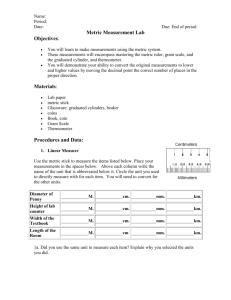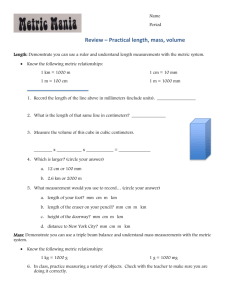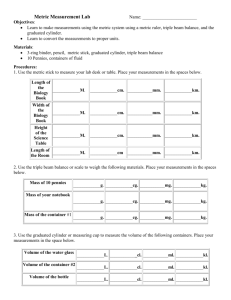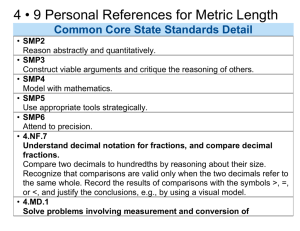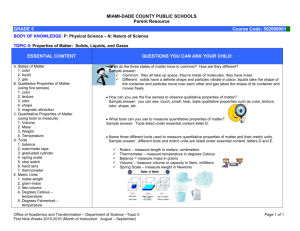Measurement - Moorpark College
advertisement
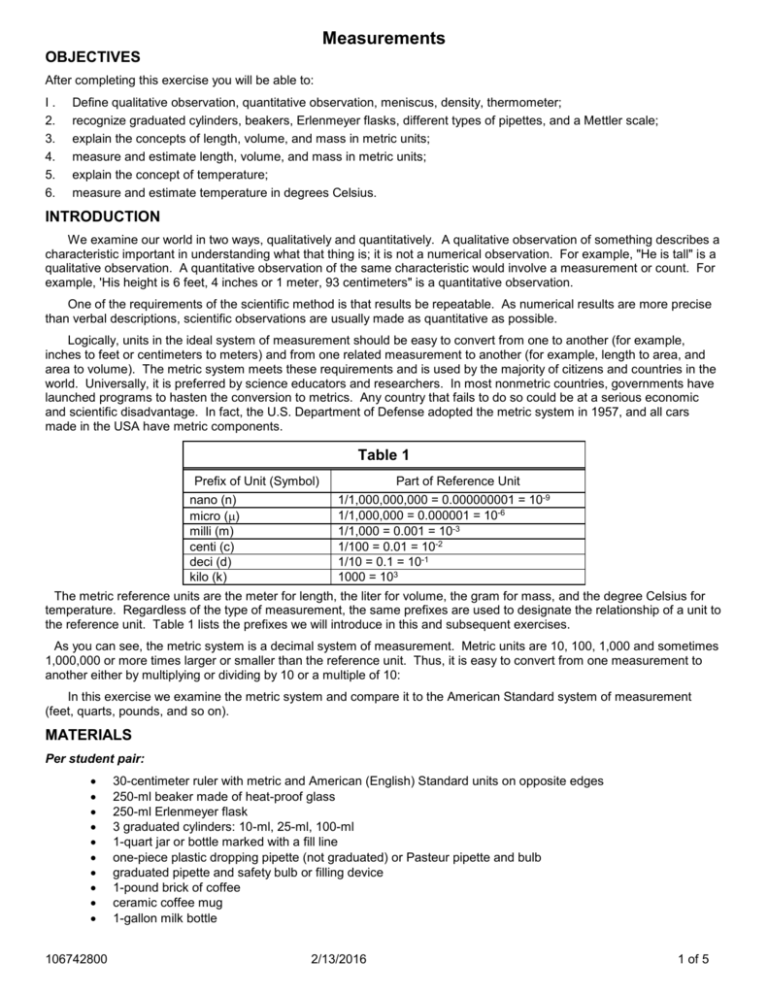
Measurements OBJECTIVES After completing this exercise you will be able to: I. 2. 3. 4. 5. 6. Define qualitative observation, quantitative observation, meniscus, density, thermometer; recognize graduated cylinders, beakers, Erlenmeyer flasks, different types of pipettes, and a Mettler scale; explain the concepts of length, volume, and mass in metric units; measure and estimate length, volume, and mass in metric units; explain the concept of temperature; measure and estimate temperature in degrees Celsius. INTRODUCTION We examine our world in two ways, qualitatively and quantitatively. A qualitative observation of something describes a characteristic important in understanding what that thing is; it is not a numerical observation. For example, "He is tall" is a qualitative observation. A quantitative observation of the same characteristic would involve a measurement or count. For example, 'His height is 6 feet, 4 inches or 1 meter, 93 centimeters" is a quantitative observation. One of the requirements of the scientific method is that results be repeatable. As numerical results are more precise than verbal descriptions, scientific observations are usually made as quantitative as possible. Logically, units in the ideal system of measurement should be easy to convert from one to another (for example, inches to feet or centimeters to meters) and from one related measurement to another (for example, length to area, and area to volume). The metric system meets these requirements and is used by the majority of citizens and countries in the world. Universally, it is preferred by science educators and researchers. In most nonmetric countries, governments have launched programs to hasten the conversion to metrics. Any country that fails to do so could be at a serious economic and scientific disadvantage. In fact, the U.S. Department of Defense adopted the metric system in 1957, and all cars made in the USA have metric components. Table 1 Prefix of Unit (Symbol) nano (n) micro () milli (m) centi (c) deci (d) kilo (k) Part of Reference Unit 1/1,000,000,000 = 0.000000001 = 10-9 1/1,000,000 = 0.000001 = 10-6 1/1,000 = 0.001 = 10-3 1/100 = 0.01 = 10-2 1/10 = 0.1 = 10-1 1000 = 103 The metric reference units are the meter for length, the liter for volume, the gram for mass, and the degree Celsius for temperature. Regardless of the type of measurement, the same prefixes are used to designate the relationship of a unit to the reference unit. Table 1 lists the prefixes we will introduce in this and subsequent exercises. As you can see, the metric system is a decimal system of measurement. Metric units are 10, 100, 1,000 and sometimes 1,000,000 or more times larger or smaller than the reference unit. Thus, it is easy to convert from one measurement to another either by multiplying or dividing by 10 or a multiple of 10: In this exercise we examine the metric system and compare it to the American Standard system of measurement (feet, quarts, pounds, and so on). MATERIALS Per student pair: 106742800 30-centimeter ruler with metric and American (English) Standard units on opposite edges 250-ml beaker made of heat-proof glass 250-ml Erlenmeyer flask 3 graduated cylinders: 10-ml, 25-ml, 100-ml 1-quart jar or bottle marked with a fill line one-piece plastic dropping pipette (not graduated) or Pasteur pipette and bulb graduated pipette and safety bulb or filling device 1-pound brick of coffee ceramic coffee mug 1-gallon milk bottle 2/13/2016 1 of 5 metric tape measure 1-liter measuring cup thermometer with both Celsius ( ºC) and Fahrenheit (ºF) scales 20º to 110º C hot plate 3 boiling chips thermometer holder Per student group: a Mettler electronic scale Per lab room: deionized water metric bathroom scale source of ice PROCEDURE A. Length Length is the measurement of a line, end to end. The standard unit is the meter, and the most commonly used related units of length are: 1,000 millimeters (mm) = 1 meter (m) 100 centimeters (cm) = 1 m 1,000 m = 1 kilometer (km) For orientation purposes, the yolk of a chicken egg is about 3 cm in diameter. Since the differences between these metric units are based on 10 or multiples of 10, it is fairly easy to convert a measurement in one unit to another. 1. For example, if you wanted to convert 1.7 km to centimeters, the first step would be to determine how many centimeters there are in 1 km. Remember, like units may be canceled. 100 cm/m X 1,000 m/km = 100,000 cm/km The second step is to multiply the number by this fraction. 1.7 km X 100,000 cm/km = 170,000 cm The last calculation can also be done quickly by shifting the decimal point five places to the right. 1.700000 km = 170,000 cm Alternatively, conversion of 1. 7 km to centimeters can be done by adding exponents. 1.7 km X 102 cm/m X 103 m/km = 1.7 X 105 cm = 170,000 cm Using the most comfortable method, calculate how many millimeters there are in 4.8 m. ______ mm Now, convert 17 mm to meters. or shift the decimal point three places to the left or add exponents Calculate how many kilometers there are in 16 cm. ______ km 106742800 2/13/2016 2 of 5 2. Precisely measure the length of this page in centimeters to the nearest tenth of a centimeter with the metric edge of a ruler. Note that the space between each centimeter is divided by nine lines into 10 millimeters. The page is __________ cm long. Calculate the length of this page in ______ millimeters, ______ meters, and ______ kilometers. Now repeat the above measurement using the American Standard edge of the ruler. Measure the length of this page in inches to the nearest eighth of an inch. ___________ in Convert your answer to feet and yards. _______ ft _______ yd It is much easier to convert units of length in the metric system than in the American Standard system. B. Volume Volume is the space a given object occupies. The standard unit of volume is the liter (l), and the most commonly used subunit, the milliliter (ml). There are 1, 000 ml in 1 liter. A chicken egg has a volume of about 60 ml. The volume of a box is the height multiplied by the width multiplied by the depth. The amount of water contained in a cube with sides 1 cm long is 1 cubic centimeter (cc), which for all practical purposes equals 1 ml. 1. How many milliliters are there in 1. 7 liters? ___________ ml How many liters are there in 1. 7 ml? ___________ l 2. Pour some water into a 100-ml graduated cylinder and observe the boundary between fluid and air, the meniscus. Due to surface tension the meniscus is curved, not flat. The high surface tension of water is due to its cohesive and adhesive or "sticky" properties. Draw the meniscus. The correct reading of the volume is at the lowest point of the meniscus. 3. Using the 100-ml graduated cylinder, pour water into a 1-quart jar or bottle. About how many milliliters of water are needed to fill the vessel up to the line? __________ ml 4. Pipettes are used to transfer small volumes from one vessel to another. Some pipettes are not graduated (for example, Pasteur pipettes and most one-piece plastic dropping pipettes). Other pipettes are graduated. Fill a 250-ml Erlenmeyer flask with distilled water. Use a plastic dropping pipette or Pasteur pipette with a bulb to withdraw some water. To find out how many drops there are in 1 ml, count the number of drops needed to fill a 10-ml graduated cylinder to the 1-ml mark. There are _______________ drops/ml. C. Mass Mass is the quantity of matter in a given object. The standard unit is the kilogram (kg), and other commonly used units are the milligram (mg) and gram (g). There are 1,000,000 mg in 1 kg and 1,000 g in 1 kg. A chicken egg has a mass of about 60 g. 1. How many milligrams are there in 1 g? _________ mg Convert 1. 7 g to milligrams and kilograms. ________ mg _______ kg 2. Our 1-cc cube in section B, if filled with 1 ml of water, would have a mass of 1 g (fig. 2-1). The mass of other materials depends on their density (water is defined as having a density of 1). Density 106742800 Mass Volume 2/13/2016 3 of 5 Approximately how many liters are present in I cubic meter of water? As each of the sides of 1 cubic meter are 100 centimeters in length, it is easy to calculate the number of cubic centimeters (that is, 100 cm x 100 cm x 100 cm = 1,000,000 cc or 1,000,000 cm3 or 1 X 106 cm3). Now just change cc to ml and convert 1, 000, 000 ml to liters. ________ l In kg, what is its mass? ________ kg Contemplate calculating how many pounds there are in a cubic yard of water. It is easier to convert between different units of the metric system than those of the American Standard system. 3. Determine the mass of an unknown volume of water. Mass may be measured with an electronic scale or Mettler balance. The lab instructor will demonstrate the use of the Mettler balance.1 Practice using the scale by weighing different coins. Add an unknown amount of water to a beaker and determine the mass using the scale. The mass of the water will equal the combined masses of the beaker and water minus that of the beaker alone. Don’t tare weigh the beaker for this exercise. mass of the beaker plus the water _______ minus the mass of the beaker _______ equals the mass of the water _ ______ Now measure the volume of the water in milliliters with a graduated cylinder. What was the volume? ______ml You may have wondered why we have avoided the term weight in the above discussion. That is because mass is a quantity of matter, while weight depends on the gravitational field in which the matter is located. Thus, if you were on the moon you would weigh less, but your mass would be the same as on earth. Although it is technically incorrect, mass and weight are often used interchangeably. 4. Using the Mettler balance, determine the mass of, or weigh, a small candy bar provided in grams to 0.01 g. Compare the weights of the candy bars in the class by putting a table on the chalk board and entering the values. ______ g D. Estimation of Measurements Now that you have had some experience using metric units, let's try estimating the measurements of some everyday items. 1. Estimate the length of your index finger in centimeters. _____ cm 2. Estimate your lab partner's height in meters. _____ m 3. How many milliliters will it take to fill a ceramic coffee mug? _____ ml 4. How many liters will it take to fill a 1-gallon milk bottle? _____ l 5. Estimate the weight of some small personal item (for example, loose change) in grams. _____ g 6. Estimate your or your lab partner's weight in kilograms. _____ kg 7. Transfer your estimates to Table 2. Then check each of your results using either a ruler, metric tape measure, 100-ml graduated cylinder, 1-liter measuring cup, or metric bathroom scale, recording your measurements in table 2. Complete table 2 by calculating the difference between each estimate and measurement. 1Remember to tare the weighing boat. 106742800 2/13/2016 4 of 5 Item Estimate Measurement EstimateMeasurement 1 cm cm cm 2 m m m 3 ml ml ml 4 l l l 5 g g g 6 kg kg kg E. Temperature The degree of hot or cold of an object is temperature. More specifically, it is the average kinetic energy of molecules. Heat always flows from high to low temperatures. This is why hot objects left at room temperature always cool to the surrounding or ambient temperature, while cold objects warm up. Consequently, to keep a heater hot and the inside of a refrigerator cold requires energy. Thermometers are instruments used to measure temperature. 1. Using a thermometer with both Celsius (ºC) and Fahrenheit (ºF) scales, measure room temperature and the temperature of cold and hot running tap water. C F Room temperature Cold running tap water Hot running tap water 2. Fill a 250-ml beaker with ice about three-fourths full and add cold tap water to just below the ice. Wait for three minutes and measure the temperature. Ice water _______ºC _______ºF Remove the thermometer and discard the ice water into the sink. 3. Fill the beaker with warm tap water to about three fourths full and add three boiling chips. Use a thermometer holder to clip the thermometer onto the rim of the beaker so that the bulb of the thermometer is halfway into the water. Boil the water in the beaker by placing it on a hot plate. After the water boils, record its temperature. Boiling water _______ºC _______ºF Turn off the hot plate and let the water and beaker cool to below 50ºC before pouring the water into the sink. 6. The formulas for temperature conversions are: 9 Farenheit = (Celsius)( ) 32 5 106742800 5 Celsius = (Farenheit - 32)( ) 9 2/13/2016 5 of 5
